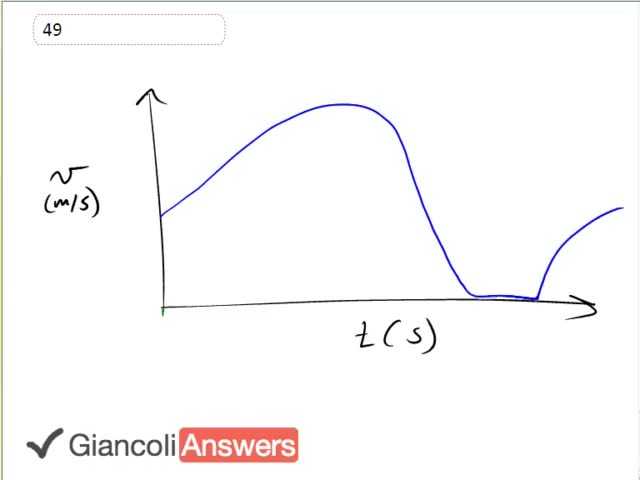
b)87s to 108s
c)0 to 40s, 60s to 80s, 87s to 108s
d)60s to 80s

In order to watch this solution you need to have a subscription.
This is a graph of the train’s velocity with respect to time. The first question asks, when was its velocity greatest? And that will be at this peak because the Y-axis is velocity and so this is the highest point on this velocity-time graph and it represents the highest velocity furthest up this vertical Y-axis. So that’s part a. This peak happens at approx forty eight seconds, so at forty eight seconds the velocity is maximum. Part b asks: during what periods was the velocity constant? And that is during this time when the velocity-time graph is horizontal and that means the velocity is not changing so at all times it is zero it’s right along the X-axis. So velocity doesn’t change from here to here because it stays zero. So for part b our answer is between eighty seven seconds to about one hundred and eight seconds. Your answers might be a little different depending on how you interpret the X-axis and where exactly these points lines up and that’s fine, it’s open to interpretation. Part c asks: during what period was the acceleration constant? And the acceleration is the rate of change in velocity so it represents the slope of the velocity time graph. The slope is the acceleration and so when the slope is constant it means the acceleration is constant because the slope and acceleration are the same. And the slope appears to be constant or a straight line in other words here up until this point when it starts to curve as it’s accelerating negatively. So up to this point here it seems to be a straight line and so say from zero to forty seconds is one constant acceleration interval. It also appears to be on a straight line starting at about here to here so just before it starts to curve into this zero velocity at this point we’ll say at about sixty seconds to eighty seconds. Again the acceleration is constant here when the velocity is zero, the velocity stays zero for sometime and that means the acceleration also is zero and a different way of looking at it is to say that the velocity-time graph is a straight horizontal line here so acceleration also is constant there. So that’s about eighty seven seconds to a hundred and eight seconds. Part d says: when was the magnitude of the acceleration greatest? Knowing that acceleration is the slope of the velocity time graph we are looking for the place where the slope is steepest and it says magnitude of the acceleration so it could be either sloped positively or negatively, it doesn’t matter we are just looking at the biggest number and that would be here it’s steepest. So we’ll say between sixty seconds to eighty seconds the acceleration has the greatest magnitude.